Celluloid – A Firm Maybe
This article was published in Knife World Publications February of 2000. It expands on an earlier article that was done in the OKCA Knewsletter.
by ibdennis
Pocket knives or razors made of celluloid are colorful, bright, durable and ornamental. This synthetic material was widely used from just before the turn of the century until about 1940. You might hear some negative comments concerning celluloid made by collectors, all of which are most likely true; but for the most part, the average knife collector knows little about this handle material. I am hopeful that this article will clarify some of the aspects of celluloid; but more importantly, I want to make everyone aware that celluloid is a potential time bomb. A time bomb which no doubt can and could destroy some special knives that you have in your collection.
Celluloid was cheap, easy to work with, tough and colorful. The use of celluloid in making commercial products of all sorts started just prior to the turn of the century, however the real popularity of this material came in the 1920’s and 30’s. There were many products that were made from the celluloid material, but we will be interested only in knife handles made from celluloid. The handles of the red white & blue patriotic scout style knives of the early 1920’s were made of this material, as were the clear handled picture knives and the “Christmas” colored knives. Razor collectors will also agree to the numerous variations on a theme on the celluloid used as handles on razors. You might also recognize celluloid on advertising knives, as they would be easy to mark with advertising names and slogans. The material had its followers, however there were some who affectionately referred to celluloid as “Genuine Mother-of-Toilet Seat.”
We call this material “celluloid,” but that is a trade name much like “Kleenex.” The first synthetic plastic material was synthesized in 1856 by Alexander Parkes, and then later was developed as a commercial product in 1869 by John Wesley Hyatt. Cellulose dinitrate or pyroxylin was blended with pigments, fillers, camphor and alcohol to make this unique synthetic material. When heated, it is pliable and can be made into a variety of shapes and forms. In the paste form, it can be colored, rolled or formed into shapes. This was an absolute dream material for knife handles, except for the few problems that came up over the course of time.
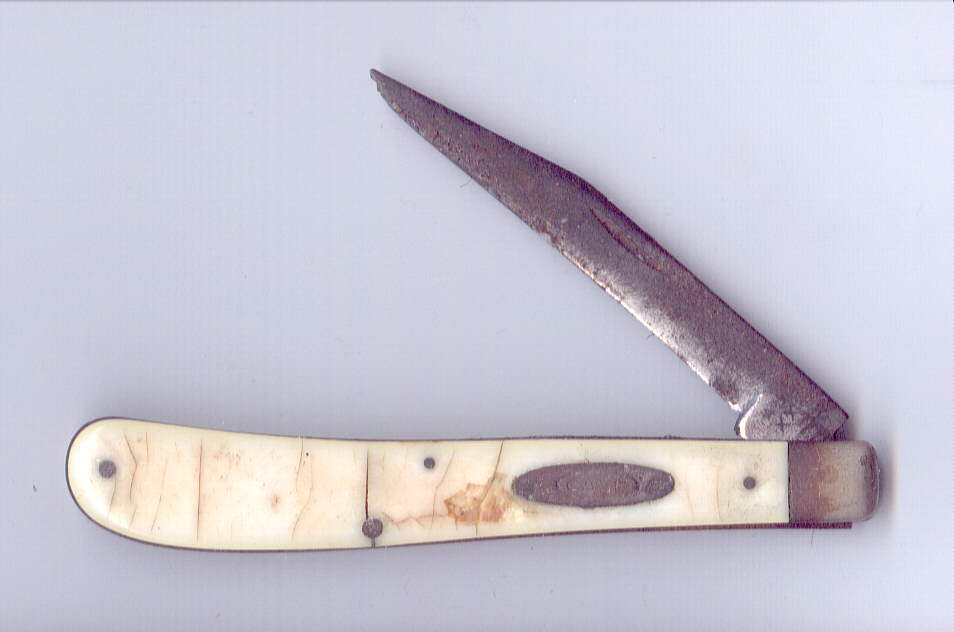
This Case single blade knife is celluloid at its worst.
To be more accurate we should refer to knife handles made of celluloid, cellulose dinitrate or pyroxylin; however I see little harm in using the term celluloid as we have in the past. Sometime in the 1940’s or 1950’s, the use of celluloid on knives was discontinued. The reason was that any of the nitrate products have a special characteristic called “flammability.” Cellulose dinitrate is kissing cousins to cellulose trinitrate (nitrocellulose) which is “guncotton.” Guncotton is an explosive substance and a propellant. The early makers of celluloid handled knives used terms for their products like pryremite, pyralin, perfected stag, shell, pearl, ivoroy, composition and other names that they found suitable for the purpose of marketing. In looking through the catalogs, the word “celluloid” is avoided as much as possible. The reason appears to be the flammability issue. If you dissect the pyremite & pyralin terms used by Remington, you will discover the word “pyro,” which means fire. I suspect that the public was not aware of this in the purchase of a knife with this type handle material.
Whenever I purchase a celluloid handled knife, I await the day that decomposition and destruction of the handle will start. The decomposition can take many forms. The most noticeable is the rusting of the knife blade or metal parts of the knife. If you open the blade of a suspect celluloid handled knife, you will note rust or a rust stain on the upper part of the blade (opposite the blade edge), while the balance of the blade will not be rusted. Without care the whole blade will rust. The next problem associated with celluloid handles will be the self destruction of the handle itself; it will shrink, crack and crumble on the frame of the knife. I have tried numerous tricks to save a celluloid handle, but to no avail.
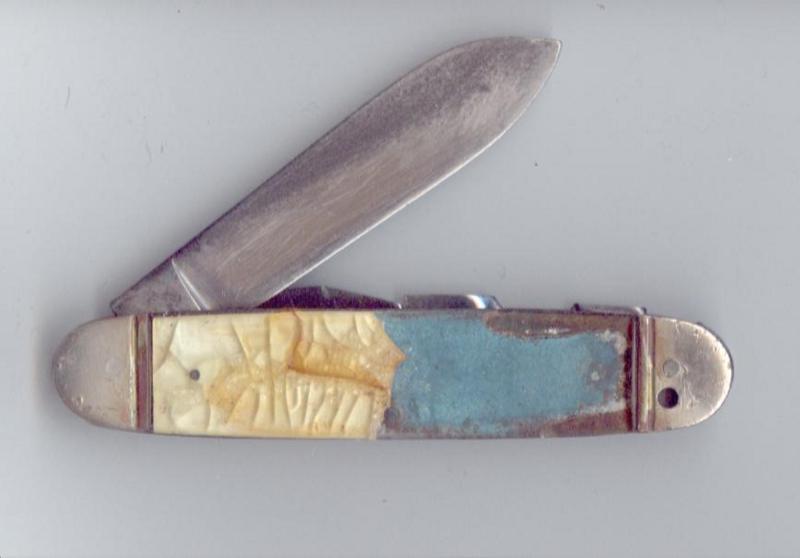
The rear celluloid handle of this Camillus 1939 Worlds Fair knife is decomposing to the point of cracking and breaking off. The blade shows rusting stains from the leeching effect of the celluloid.
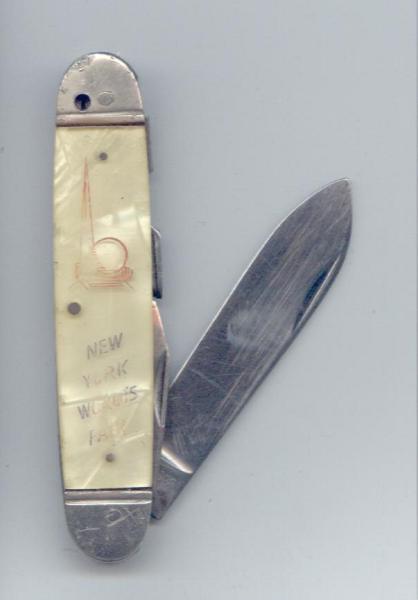
The front celluloid handle of the 1939 Worlds Fair knife shows no visible signs of decomposition, in contrast to the rear handle. This does not mean that it is not decomposing.
What I have done in the past is isolate the knives that are suspect, clean them often and make sure that they do not come in contact with any other knives. This is only a very temporary stop gap procedure, as eventually they can go to total self destruct. So what is happening, and what can be done about these celluloid handles? Are all celluloid handles subject to decomposition? The answer, of course, is a “firm maybe.”
For years I have asked the question “What is happening to these handles?” Very few could even muster a plausible explanation. Even with the help of several research chemists and many hours of research, the answers are vague, but are impressive and startling. As to specifics: this presentation is in the realm of a “firm maybe.”
I have attempted to stop the deterioration and decomposition of celluloid knife handles in a variety of ways, but without success . However, I have slightly slowed the effects of the deterioration, even though I haven’t stopped it. I do not believe that I will provide a solution to stop this action. So my best bet is to understand and prolong the inevitable as long as I can, without destroying the knife itself.
Norman Chappelie (Cha-pel-ee) is an industrial chemist in Eugene, Oregon, who seems to have a good handle on the celluloid subject. Over lunch one day I laid out numerous samples of celluloid handled scout utility knives for his inspection. Some were heavily decomposed, and others looked as new, even though they were over 60 years old. The expression that you can’t see the forest for the trees certainly fit me this day. Norm was able to draw a conclusion rather quickly based on my samples. (He also suggested that the washing of our hands was in order after handling these knives.)
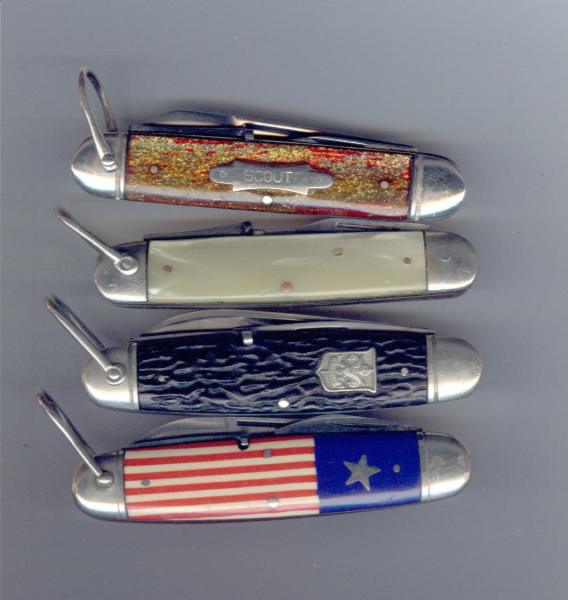
From top to bottom: IKCO 1920’s Christmas tree celluloid handled knife; Kabar light colored celluloid pearl like handles; 1930’s LF&C official BSA knife with celluloid “Perfected Stag” handles; Remington Red White & Blue celluloid (pryremite) handles.
In short order Norm separated out the obviously decomposed knives and pointed out that all these knives shared one thing in common. Each was light in color or clear. The worst of the lot was a clear handled picture knife that showed evidence of an aggressive attack from rust on the blades and bolsters. It was suggested that the clear or light colored handles did not have binding or filler material and were more subject to deterioration. The dark handles or the ones which were more opaque in nature had a binding agent. In the process of making celluloid, the “pretty” that was added to the celluloid acted as a binding or bonding agent, and by accident and not design, acted as an inhibiting agent against decomposition. Or if it does start, it does it at a very slow rate that doesn’t effect the knives radically.
Norm also pointed out that in the old days movie film was made from clear cellulose dinitrate, and we have all heard that this film is decomposing. We have also heard of the explosive effect that this film has when subjected to heat or flame. The film is clear and has no binding material which could slow or retard the chemical decomposition. It is for this reason that they speak of preserving the old films by putting them on a non decomposing film that is used today. I heard once that well over 50% of the old films have been lost to this decomposition.
Year’s ago I was on tour at Camillus Cutlery, and it was pointed out that one building was used to make their celluloid handle material when it was made years ago. The roof was metal and was hinged. If the celluloid were to catch fire and explode, the roof would release from the force of the explosion, which would save the building and the surrounding area. This action would direct the explosion upward and not outward. At the time I listened, but it was only later that I understood.
When celluloid was made there were several pretty nasty chemicals that went into the product. Sulphuric acid and nitric acid led the list of bad guys. If the resultant celluloid product was well washed and chemically manufactured, the chemicals were fairly inert. If the process was not strictly adhered to, then there could be premature decomposition. Likewise in the making of celluloid, there should have been a settling time in which the new product could shrink and settle in on its own. If it was used too soon, shrinkage of the material was noted, especially on knife handles. English knives of quality that used celluloid usually had the raw celluloid material left alone for long periods of time to minimize the shrinkage and cracking. But I said minimize, not eliminate.
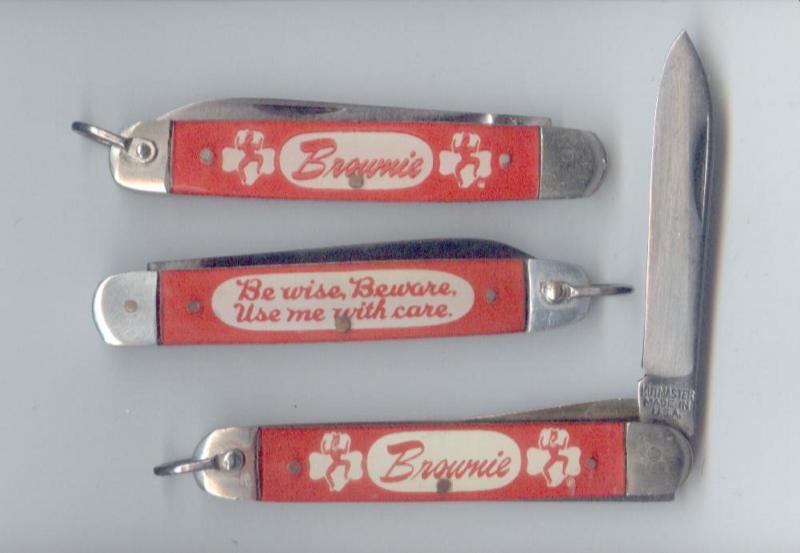
These 1950’s vintage Brownie knives by Kutmaster have been my worst nightmare. It is possible they have been exposed to an environmental trigger that has prompted their decomposition. The open knife shows heavy staining on the exposed part of the blade when closed. The “Be Wise, Beware” has a double meaning here.
Time is the ultimate test to any product, and cellulose dinitrate doesn’t fare well with time. At the time a pocket knife was made, it wasn’t thought that it would need to last as long as we collectors have made necessary. In a Remington study, it was determined that the average pocket knife had a life span of three years. So even if they knew at that time that celluloid would decompose, it was not a matter for concern since all things wear out and will only serve a given workable period of time.
But I have some concerns which bother me. If it was known after the 1940’s that celluloid was flammable and subject to decomposition, then why would collectable type knives of recent manufacture be made with this handle material? Today in the year 1999, I noted that a commercial manufacturer has introduced a line of knives that it advertises as celluloid. For today’s working market and use OK, but for history and collecting, I have concerns.
Celluloid is fairly sensitive to temperature, light, moisture and chemicals. Shrinkage is also noted, along with splitting and cracking of the material. Even though the product is susceptible to the above, the bonding material used in the celluloid can retard some of the deterioration. But we don’t know what or why or how and that again is another “firm maybe.”
I have never seen a red white and blue knife, or for that matter any of the 1930’s kitsch variegated handled knives, deteriorate. So if you think dark material is safe, that could be a “firm maybe.” We can speculate about two identical knives; one ravaged with decomposition and the other pristine. Explanations could be that the one was exposed to heat or extremes of heat, chemicals, light, moisture or other decomposing products that started the action. Once the decomposing action starts, it becomes auto catalytic, meaning it starts a reaction that is automatic and continues to decompose the material. The theory that a binding material slows or prevents this action is then plausible. However, if we take a dark celluloid material and subject it to extremes or chemicals, then it too could or might be a candidate for decay and deterioration.
I have been to summer flea markets where knives have been on display for sale in glass cases that have had the sun shining directly on them. When these cases are opened, the items inside had been exposed as if in a greenhouse, where extreme heat has built up in very short order. I have often wondered if a celluloid product in these cases wouldn’t start its decomposition process as a result of the extreme heat it had been exposed to in this situation. Likewise the same heat generation can occur if a celluloid item is displayed in a store window that is exposed to direct sunlight. The worst extreme here is the rapid heat and then rapid cooling that can chemically affect celluloid.
When a knife blade starts to rust, there is a leeching or exuded chemical reaction. This chemical is more than likely nitric acid, and this certainly explains the fast rusting on a knife blade, back springs or bolsters. My chemist friend, Norm, stated that his fingers would turn white if he handled this material very much. In my own case, my fingers burn or there is a funny sensation on my finger tips when I handle these knives. I now know that this sensation is due to the decomposition which is occurring, the nitrate exuded chemical or nitric acid. One person I talked to said that they could identify celluloid handles by rubbing the handles to get them warm, and then smelling the handles which would have a unique chemical smell. I scoffed at this, but Norm said that this was indeed possible. Many people have a nitrate sensitivity and can actually smell the chemicals. In this person’s case, the sensitivity came about due to smoking cigarettes which had nitrates in the cigarette paper which helped keep the paper and tobacco burning. Those who smoke can develop a nitrate sensitivity. In my case I could smell nothing. Does ibdennis smoke? Nope by gum; and therefore dear elayne suggests that I missed my opportunity to become a professional celluloid sniffer.
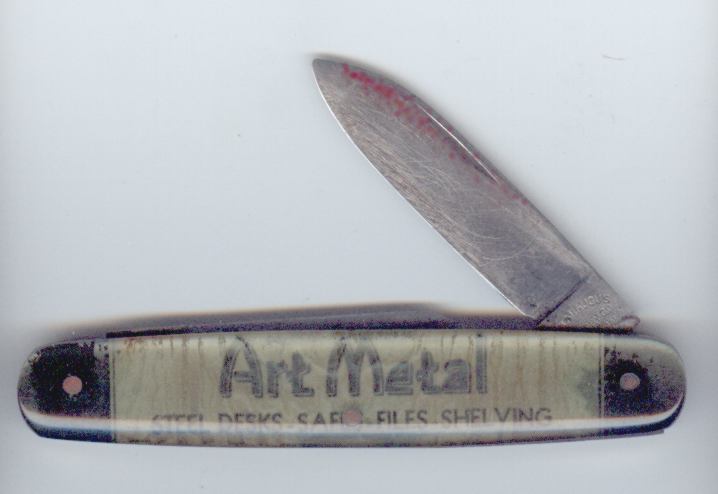
This Cattaraugus advertising knife is undergoing massive decomposition from the celluloid handles.
The use of cellulose dinitrate was common up until the 1940’s. After that time, the use of cellulose acetate became popular. This product was not flammable like its predecessors, but it still had some decomposition and deterioration problems. Here again time, light, temperature and chemicals were partners in this act.
I spoke with someone at a cutlery factory one time, and they stated that the decomposition of handles made from cellulose acetate was caused by putting knives into clothing drawers where the darkness caused acetic acid to leech out and decompose the handles and rust the blades. This person had no doubt heard that at the time handles were made from cellulose acetate. I questioned this idea, but Norm said that there was possible truth in this theory. The decomposing chemical in this case would be acetic acid. It is possible that a chemical action could be started from chemicals in the fabrics, and the acid could build up in the confined location. Light colored handles again could be suspect, as they would lack the binding material. In contrast to this would be having the same product out in the open and allowing the gases to dissipate more easily. What is actually the case is unknown, but the theory causes further thoughts which fall into the realm of a “firm maybe.”
So the conclusions that can be drawn are somewhat vague, but some finger hold of truth can be extracted. Chemical actions are at play that can cause decomposition of the handles and rusting of metal. This action can be started by heat, light, moisture or chemical reactions or from other chemicals placed in close contact. Cracking, shrinking, warping and the release of chemical gases can be products of this decomposition in cellulose dinitrate based handles. In the case of cellulose acetate handles we know that the fire or flammable aspect is not a problem, but we can suspect shrinkage, cracking and the release of chemical gases might take place. From my observations these are more prevalent in light colored handles. And that too is a “firm maybe.”
Likewise it should be noted that light colored or clear celluloid handles may have survived beautifully over the years without decay or decomposition. That does not mean that something cannot suddenly occur that will change this. Call it a chemical time clock or environmental warming or introduced environment changes or whatever…. it could happen. Or if you want to take a more Polly Anna approach, you could say that the chemical composition of this batch of celluloid was made so that chemical decomposition will not occur. Right! Now about that beach front Arizona property that dear elayne bought, and we would like to sell to you.
At one time we collected melon, sausage or produce knives. These knives are characterized by long handles and blades. Celluloid was an ideal handle material for these knives. The handles were light in color for sanitary reasons, and they could be washed without damage. They also lent themselves to advertising, which stood out on the white background. In our collection we were constantly battling which knife was leeching, as it wasn’t always the one which was rusted. A celluloid decomposition on a stainless knife could attack its neighbor first if it were made from carbon steel. For years we played the “Who’s on first” game until we finally tired of it. We never seemed to win. Here again the telltale clues were the celluloid handles, and the light colored material that was apparently short on bonding additives.
The sad part of this phenomena is to observe collections that have celluloid objects in them that are under glass and have started the chemical reaction. These can be in museums or personal collections. Of course being under glass can be like being in a greenhouse, especially if there are external lights played on these cases. The best advice I can offer is to make the curator aware of this so that the problem can be properly addressed in a manner befitting the collection. The process of destruction is subtle and can go undetected to the casual observer. As knife collectors and makers, we should be able to spot this rather quickly now that we know what to look for.
I contacted several museums in my search for celluloid information, and every curator was very aware of the time bomb effect of celluloid products. The most illustrative example that I heard regarding this material was the sculpture art object that was created out of celluloid. This item was quite large and was kept on view in a glass case. It was noted at one time that there was liquid pooling in the low spots of the sculpture, and that there appeared to be droplets of liquid on most of the surface. This sculpture was a fine example of chemical decomposition occurring due to a confined enclosure, heat from lights and the ravages of time. I am told that the liquid was high in nitric acid .
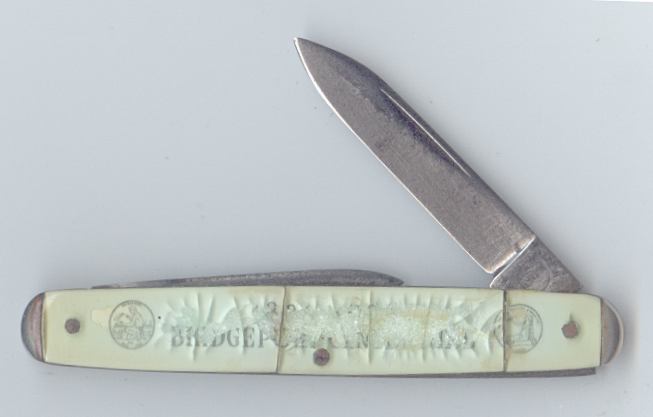
This rare Remington two blade knife has the date 1936 on it commemorating a Bridgeport celebration. The handles are so decomposed that the event is barely readable.
One author had a solution to the problem of the decomposing celluloid knife or razor handle. If you see one for sale; run the opposite direction. If you discover one in your collection; throw it away. That is no doubt sound advice, but I can’t come to grips with these solutions. I know that heavy oils or protection wax slows the damage but does not completely protect it. Stop gap technology. Of more important note is that some of these chemical cures could be adding to the problem and speeding the decomposition problem. I do not recommend oils, chemicals or waxes be used on celluloid.
My attempts at stopping the deterioration have been terribly disappointing . I have placed a single knife in a jar that has silica gel crystals in it. I had hoped that the leeching gases or chemicals would be captured by the gel, and it would not get a chance to damage the knife. It didn’t take long (weeks) to learn that this method did not work.
I also tried placing a celluloid handled knife in a plastic bag after protecting it with oil. Talk about increasing the chemical decomposition and destruction. The trapped gases and nitric acid made quick work on the vulnerable parts of the knife. So I have resorted to placing the knives out in the open and watching them closely. It stopped nothing, but has slowed the observable action a little.
The latest test I did was to place the celluloid knife in a jar with silica gel in the freezer. If a rise in temperature increases decomposition, then cold should slow it down. Likewise if light causes decomposition, then the dark of the freezer should also retard decomposition. And it does. Slows it down, but does not stop it. Due to the inconvenience of placing knives in the freezer, this is not a recommendation. Aside from that, the celluloid has an increased tendency to crack at the rivet stress points in the cold environment. Just like the teeter totter; when one side goes up the other goes down. And that is not a “firm maybe.”
There is another good solution, and that is to replace the handles completely. This solution destroys the historical significance of the specimen, but it does save the metal. It also saves other knives in your collection from being polluted.
The question has arisen as to how does one identify celluloid handles from other synthetic handles. There is no easy way save for a destructive test. That destructive test is to burn the material. If it burns with a dense hard flame like napalm, then it is celluloid. It only takes a very small piece to let you know the explosive nature of this material. A word of caution: do not breath the fumes, as these fumes can be toxic. In fact unless you have to, don’t burn celluloid. Likewise the burned residue is not good for you, either.
With a little help from my friends Jim & Cindy Taylor, Mark Zalesky and Michael Yoh, I received numerous pieces of discarded “synthetic” handles so I could identify if they were celluloid. Everything I torched was celluloid. This included the yellow handled Case, KaBar, Utica, Imperial and Westco knife handles. I had always wondered about the pearlized Imperial handles, and they too went up in a ball of fire. Landers Frary & Clark (LF&C) made a handle material called “perfected stag” which I always suspected as being celluloid. Without a doubt, as the ball of fire attested, these handles were made of celluloid. The “Perfected Stag” handles were celluloid with a very dark binding material that was molded to look like animal stag. The real surprise to me was the Fight’n Rooster handle that left no doubt that this too was celluloid.
Fight’n Rooster celluloid knives are a product that started in 1976. The handle material came from Germany, and I would like to think that there was not an awareness of the potential for deterioration of this material. These knives are lovely to behold, and the celluloid handles play a part in this beauty. It is thought that under proper conditions and storage that these knives would present little or no problems. But the big issue here, as stated in this article, is the proper care for these knives and being aware of a potential problem. Since these knives are a rarity on the West Coast, I have little first hand knowledge of these particular knives. However from a previous article that I wrote on the celluloid subject that appeared on the Internet, I have been advised that the Fight’n Rooster knives do indeed decompose, and the process is being observed in some collections.
Many of the samples I was given for testing and burning purposes had all the telltale signs of deterioration and decay. The handles not only looked like they were in trouble, but the cracking and checking was rampant.
Working with and using celluloid requires some special considerations, or you will be courting disaster. Anything that can generate heat can create a flame point with this material. Buffing or cutting celluloid can generate heat, and the results can be ashes in your hands. If you must work this material, do it so that no heat is generated. Again any gases put off in this process should be considered toxic. Generally speaking, if you don’t have need to do anything with this product, then don’t.
I have several celluloid handled knives that I fuss over, as I always suspect that for some reason they will start their destructive dance. I exercise some cares and cautions with these knives in hopes that I might be lucky. I try to store these knives in dark drawers that have a consistent ambient room temperature. The knives are also stored on top of acid free paper so that a fabric will not trigger a reaction. Most important is that I check on these knives often and frequently, so that I can note impending doom and disaster. One ounce of prevention goes a long way. How often should you go through your collection? You can’t do it too often. Bolsters, shields, handle pins and the exposed parts of blades are first order of concerns. If there is even the slightest discoloration, further examination is a must. Look for a reddish powdery dusting on knife blades. If the smooth portion of a blade feels just a little bit rough, then there is a chance that rusting is starting. Above all do not put off preventative measures, or you will regret it and that for sure is not a “FIRM MAYBE.”
Copyright (C) 1999 Knife World Publications. No part of this article may be reproduced without permission.
